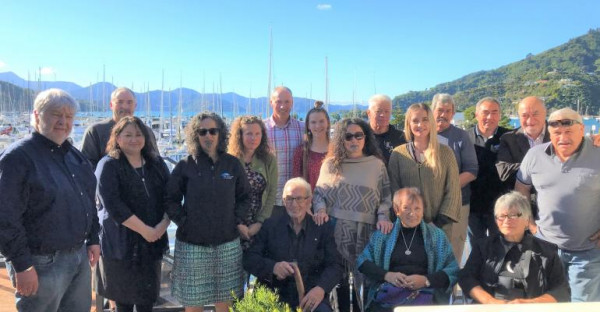Posted on 29 July 2019
Students unite kaitiaki and science for better marine outcomes
- News
- Kaitiakitanga Schools, education and communities Tikanga and mātauranga Māori Dynamic Seas Vision Mātauranga Marlborough/Te Tauihu-o-te-waka
- 2 Minutes to read
Sharing their learnings about the marine ecosystem with iwi in the Marlborough Sounds (Te Tau Ihu o te Waka-a-Māui) has been an enlightening experience for three students.
The students, all with connections to Te Ātiawa, were invited to speak at a hui held at the Waikawa Marae in Picton at the end of May. At the hui, they described their experiences working alongside researchers from the Tipping Points projects in the Sounds for three days in November 2018.
Justine Newnham, George Moloney and Moana Joyce joined researchers from the University of Auckland, Canterbury and Waikato, and NIWA surveying the health of the outer Queen Charlotte Sound. The team were monitoring the extent of kelp forests or kina (sea urchin) barrens in rocky reef habitats and using underwater cameras to assess the health of the seabed. There was also opportunity for the students to discuss marine environmental issues with the team.
At the hui, the students presented their thoughts and reflections on science, environmental issues and their relationships with the Sounds.
“We are all striving to achieve the same goal – sustainable seas for the future generations to come. And although we have different perspectives, Māori from a Kaitiaki perspective and non-Māori from a science perspective; if we collaborate and join forces, positive outcomes for our seas will happen more rapidly,” says Moana.
They were supported by Professors Conrad Pilditch (University of Waikato) and Simon Thrush (University of Auckland). “It was great to see the strength of connections between the students, and Te Ātiawa trustees and kaumatua,” explains Conrad. “They discussed whakapapa, genealogy, their connections to the area, and the challenges faced by the unique environment.”
Local Kaitiaki Planner, Ian Shapcott, who has worked in the rohe for more than four decades hopes that the research will continue to support the mahi (work) of the Te Ātiawa Manawhenua Ki Te Tau Ihu Trust.
“All information is vital and supports the role of Te Ātiawa as kaitiaki. In helping the sustainable management of te taio (nature) here, a pathway can then be opened to enable this model to be repeated Aotearoa wide,” he explains. He is also eager to see more young people getting involved and connecting with their environment.
This field trip and hui attendance were funded by the Vision Mātauranga (VM) programme. In Phase II, VM will continue to be embedded in all research projects to help build capability and capacity, and strengthen relationships with iwi, hapū and Māori organisations.

[L to R, standing] Simon Thrush, Darryl Moloney, Trustee Vennessa Ede, Trustee Joy Shorrock, Justine Newnham, Conrad Pilditch, George Moloney, Trustee Cindy Batt, Trustee Harry Love, Moana Joyce, Trustee and Deputy Chair, Ron Riwaka, Trustee Billy Reeves, Archdeacon Emeritus Harvey Ruru QSM, Trustee and Chair, Trustee John Katene. [L to R seated] Matua Neville Tahuaroa-Watson, Whaea Amo Poki and Whaea Linda Ohia